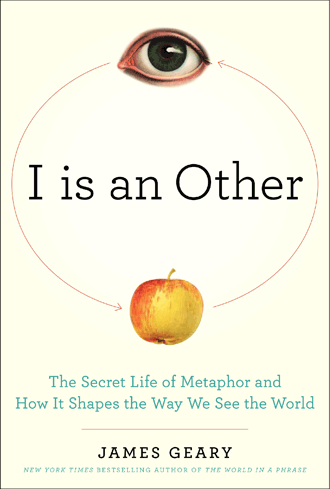A Jaw Dropper From James Geary
March 21, 2011A good measure of how much I enjoyed a book is the amount of pencil I leave on its pages. Underlined passages, exclamation marks, and scrawled margin notes bear irreproachable witness to an author’s ability to make synapses sparkle.
So, one need only glance at the ocean of graphite smeared across James Geary’s I is an Other to know I found it engaging and provocative. James, who is my editor at Ode Magazine, explains the role of metaphor in our language and shows how metaphorical thinking was essential to the evolution of human consciousness. It is the kind of book that makes you go ‘wow’ at least once a page.
According to James, the average person uses a metaphor every 10 to 25 words, or about six metaphors a minute when speaking. He divides these metaphors into three categories. Active metaphors are those whose images are intellectually startling and bring us a fresh perspective on an idea. An example he cites is Wyndham Lewis’ definition:
Laughter is the mind sneezing.
Next are dormant metaphors, clichés that have entered our language and no longer provoke new insights but instead represent a universally accepted idea or condition. To illustrate, Geary uses:
We’re getting in over our heads.
Finally, our language is littered with extinct metaphors, metaphors that arose long ago to explain a phenomena but that most people wouldn’t even recognize as a metaphor today. Typical is the phrase to explain the concept of understanding:
I see what you mean.
The reason our language is embedded with metaphors is because they were the vehicle that allowed human knowledge to expand and advance. The human brain is built to seek out patterns because understanding patterns – lions tend to maul, fire tends to burn, hemlock tends to poison – helps eliminate risk and ensures the survival of our species. So, whenever a person encounters something new, the brain tries to fit it into existing patterns to make sense of it: ‘Aha! Tigers are like lions! Beware!’ Thus, all new experience is metaphorical because it is understood through the lens existing knowledge. Carl Jung goes so far as to suggest a few archetypal experiences are the platform from which all human knowledge and understanding metaphorically arises.
I could go on, but why bother when James has already explained it much better and much more poetically than I ever could? I is an Other: The Secret Life of Metaphor and How It Shapes the Way We See the World is an essential read for both writers and anyone seeking a better understanding of human existence. And, in terms of praise, everybody from the Wall Street Journal to Alyssa Milano has declared their love for the book.
You can visit James’ website here. And, if you click on the following link there is an awesome video of James giving a talk on metaphors at a TED conference: james_geary_metaphorically_speaking
(As a final aside, my pencil scratches are also one of the reasons I don’t understand Kindles and other electronic reading devices. One, I love to read on the toilet and I’m not sure I’d like to keep taking the same Kindle into my toilet day after day, week after week, month after month. A little gross, no? And, two, when you come across an engaging book, where do you make notes and jot down ideas? My library is a repertoire of word lists and half-conceived ideas and even phone numbers and shopping lists that I have written on inside covers. Where does this physical history go when you have a Kindle? And wouldn’t it be missed? I, for one, will remain loyal to the printed book for this reason alone.)
← MacKinnon in Japan On Guitar … →